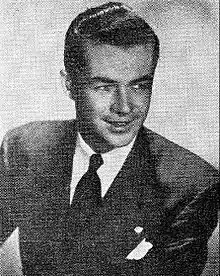Dick Joy | |
|---|---|
 Dick Joy 1947 | |
| Born | Richard W. Joy December 28, 1915 Putnam, Connecticut |
| Died | October 31, 1991 Medford, Oregon |
| Occupation(s) | Radio and television announcer, newscaster |
Dick Joy (December 28, 1915[1] – October 31, 1991) was an American radio and television announcer. A journalism major at the University of Southern California, he went on to become well known on network radio and television.[2]
Early years
Joy's involvement with radio at the local level began when, while a student at USC, he worked part-time for radio stations in Los Angeles, California. His first job after graduation was at KEHE, and he later joined the announcing staff of KNX.[3]
Radio career
At age 21, Joy moved up from the local level to CBS, becoming that network's youngest staff announcer in history.[3] By 1937, he was involved with Kathryn Cravens' News Through a Woman's Eye, Good Afternoon Neighbors, Thomas Conrad Sawyer Series Goodyear Sun-up News,[4] and The Newlyweds. In the following three years, he added to his achievements work on My Secret Ambition, Hollywood in Person, Road of Life, I Want a Divorce, College of Musical Knowledge, Burns and Allen, and The Beauty Explorer.[1]
Joy went on to be the announcer for numerous network radio programs including The Adventures of Bill Lance,[5] The Danny Kaye Show, Forever Ernest, The Sad Sack, Vox Pop,[6] The Adventures of Sam Spade, Blue Ribbon Town, Dr. Kildare.[7] Nelson Eddy Show, Those We Love,[8] Silver Theatre,[9] New Old Gold Show,[10] Jackie Coogan Show,[11] The Saint,[12] and The Danny Thomas Show.[13]
The 1946 edition of Radio Annual reported, "Dick Joy and Donald C. McBain have opened their new station, KCMJ, at Palm Springs."[14] Thus, Joy began his first venture into ownership of a station while continuing to work on network radio. His entry in the "Announcers" section of the 1947 Radio Annual listed 10 network entertainment programs in addition to newscasts.[15] He sold KCMJ in 1950.[16]
Television career
Like many artists from radio, Joy moved to television as that medium grew in popularity. TV programs for which he was the announcer included December Bride, Perry Mason, Have Gun - Will Travel, Daktari, Lost in Space, Gomer Pyle U.S.M.C., Playhouse 90.[17] and Sheriff of Cochise.[18] Radio/television columnist Glen Stadler reported that Joy eventually left television to return to radio "because he refused to act like the advertiser demanded ... using the shove-em-at-you technique." Joy told Stadler, "I don't want any more [until] the advertiser ... admits that the buyer has intelligence."[19]
Returning to local radio in 1951, Joy became news director at KFAC in Los Angeles.[20] Billboard magazine reported that, in addition to being news director, Joy would "handle all morning newscasts and some early afternoon shows."[21]
Joy also worked at two Los Angeles television stations, KTTV and KNXT. He retired in 1969.[2]
Family
Joy had a wife, Cecelia, two daughters, and three grandchildren.[2]
References
- 1 2 Grunwald, Edgar A., ed. (1940). Variety Radio Directory 1940–1941. Variety, Inc. p. 972. Retrieved 13 June 2014.
- 1 2 3 "Richard Joy; TV, Radio Announcer". Los Angeles Times. November 4, 1991. Retrieved 9 June 2014.
- 1 2 "The Story of Dr. Kildare". The Digital Deli Too. Retrieved 9 June 2014.
- ↑ Alicoate, Jack, ed. (1938). The 1938 Radio Annual (PDF). p. 663.
{{cite book}}:|work=ignored (help) - ↑ Dunning, John (1998). On the Air: The Encyclopedia of Old-Time Radio (Revised ed.). New York, NY: Oxford University Press. p. 7. ISBN 978-0-19-507678-3. Retrieved 2019-10-12.
- ↑ Buxton, Frank and Owen, Bill (1972). The Big Broadcast: 1920–1950. The Viking Press. SBN 670-16240-x. Pp. 66, 89, 206, 251.
- ↑ Dunning, John. (1976). Tune in Yesterday: The Ultimate Encyclopedia of Old-Time Radio, 1925–1976. Prentice-Hall, Inc. ISBN 0-13-932616-2. Pp. 13, 81, 165.
- ↑ Alicoate, Jack, ed. (1943). The 1943 Radio Annual (PDF). Radio Daily. p. 793. Retrieved 10 June 2014.
- ↑ "Behind the Mike". Broadcasting. September 15, 1939. Retrieved 10 June 2014.
- ↑ Abbott, Sam (October 24, 1942). "Hollywood". The Billboard. p. 6.
- ↑ Alicoate, Jack, ed. (1946). The 1946 Radio Annual. p. 832. Retrieved 10 June 2014.
{{cite book}}:|work=ignored (help) - ↑ "The Saint Radio Show". MegaloRadio.com. Archived from the original on 14 July 2014. Retrieved 11 June 2014.
- ↑ Sies, Luther F. (2014). Encyclopedia of American Radio, 1920-1960, 2nd Edition, Volume 1. McFarland & Company, Inc. ISBN 978-0-7864-5149-4. P. 177
- ↑ Alicoate, Jack, ed. (1946). The 1946 Radio Annual. The Radio Daily. p. 61. Retrieved 11 June 2014.
- ↑ Alicoate, Jack, ed. (1947). The 1947 Radio Annual. p. 896.
{{cite book}}:|work=ignored (help) - ↑ "Closed Circuit" (PDF). Broadcasting. October 23, 1950. p. 4. Retrieved 11 June 2014.
- ↑ "Here are a few more celebrities". www.coutant.org. Retrieved 11 June 2014.
- ↑ "Film People". Broadcasting. September 17, 1956. Retrieved 11 June 2014.
- ↑ Stadler, Gil (August 15, 1953). "Look and Listen". Eugene Register-Guard. Retrieved 11 June 2014.
- ↑ "air-casters". Broadcasting. December 10, 1951. Retrieved 11 June 2014.
- ↑ Bundy, June (December 22, 1951). "Vox Jox". The Billboard. p. 22.